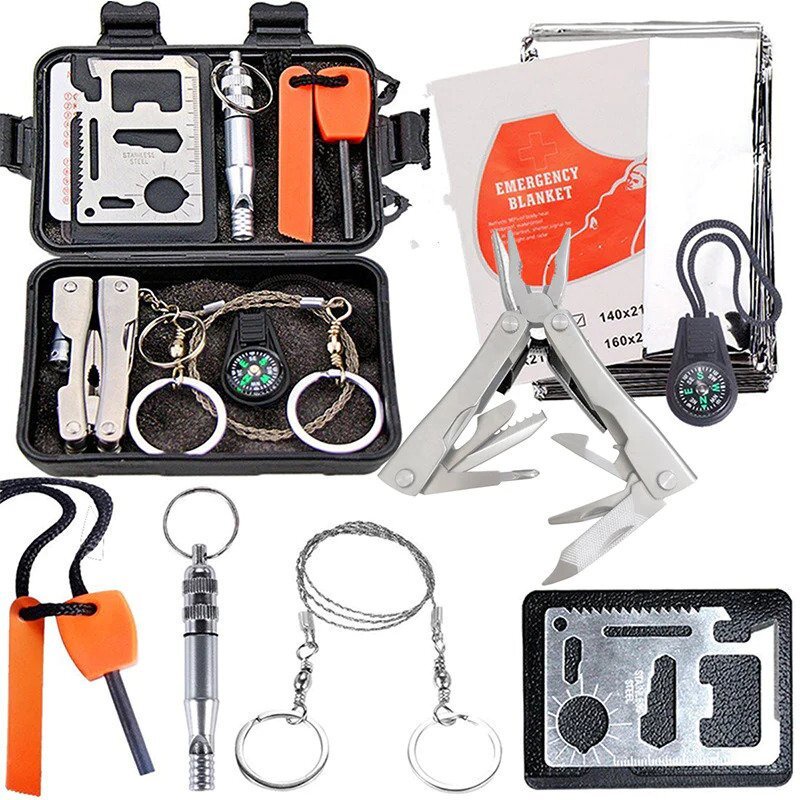The allure of survival kits, from pocket-sized essentials to full-blown gear for hypothetical apocalypses, is undeniable. But before you get lost in the wilderness of options, remember: preparation is key, but practicality reigns supreme. Let's explore three popular types of survival kits – camping, zombie (fictional), and every day – and equip you with the knowledge to build customized, relevant solutions for your needs.
camping survival kit: Embracing Nature's Challenges:
Imagine a peaceful camping trip interrupted by a sudden downpour or a lost trail. Your kit should empower you to handle such situations, focusing on essential survival and comfort.
Essentials:
- Shelter: Emergency tent, tarp, or bivy sack.
- Fire: Matches, lighter, fire starter, tinder.
- Navigation: Compass, map, GPS device.
- Water Purification: Filter, tablets, or boiling pot.
- Food: High-calorie, non-perishable options, multi-tool for opening cans.
- First Aid: Comprehensive kit with medications and wound care.
- Emergency Communication: Signaling mirror, whistle, personal locator beacon (PLB).
- Warmth: Sleeping bag, extra layers, emergency blanket.
Tailoring:
- Winter Camping: Add extra layers, hand warmers, and cold-weather gear.
- Backpacking: Opt for lightweight options, and prioritize multi-purpose items.
- Group Camping: Share some items and distribute tasks for efficiency.
Remember: Research local regulations, practice outdoor skills, and respect nature.
zombie survival kit: Fiction Meets Pragmatism:
While zombies are fictional, preparedness for any disaster is valuable. However, approach this kit with a focus on practicality and real-world emergencies, not fantastical scenarios.
Essentials:
- Same core items as the camping survival kit, with a focus on self-sufficiency and long-term survival: Water purification, food storage, shelter, first aid, and communication.
- Additional focus on security and defense: Sturdy tools, personal protection items (depending on legal and ethical considerations), knowledge of self-defense, and firearm safety (if applicable and legal).
Remember: Prioritize realistic threats, focus on skills and adaptability, and avoid perpetuating harmful stereotypes.
Everyday small survival kit: Pocket-Sized Peace of Mind:
Life is full of unexpected twists. This kit, tucked away in your bag or car, offers a compact solution to minor mishaps.
Essentials:
- First Aid: Bandages, antiseptic wipes, pain relievers, tweezers.
- Quick Fixes: Safety pins, zip ties, duct tape, sewing kit.
- Hydration: Water purification tablets or a mini filter.
- Navigation: Compass, mini map, or offline phone app.
- Communication: Portable charger, car charger, or power bank.
- Light: Flashlight or headlamp.
- Weather Warriors: Emergency blanket, hand warmers, rain poncho (optional).
Tailoring:
- Adventurer: Insect repellent, sunscreen, fire starter, whistle.
- City Dweller: Personal safety items like pepper spray or alarm.
- Commuter: Jumper cables, tire pressure gauge, basic car tools.
Remember: Compactness is key, update regularly, and practice using your kit.
Conclusion:
Survival kits are about preparedness, not paranoia. They offer peace of mind and empower you to handle unexpected situations. Choose the kit that suits your needs, prioritize practicality and skills, and remember that the real power lies in your resourcefulness and resilience. So, ditch the fantastical notions, embrace practical solutions, and build a kit that truly empowers you to navigate life's challenges with confidence.


No comments yet